#16 NW Front Street
Coupeville, Washington
Sill House / Benson's Confectionary / Liquor Store / Kingfisher Bookstore
1874 - The first building on this location was constructed as the Sill residence. A sketch map from the 1870s indicates that it was a saloon at one point.
Later it held a Meat Store and a Watch Maker.
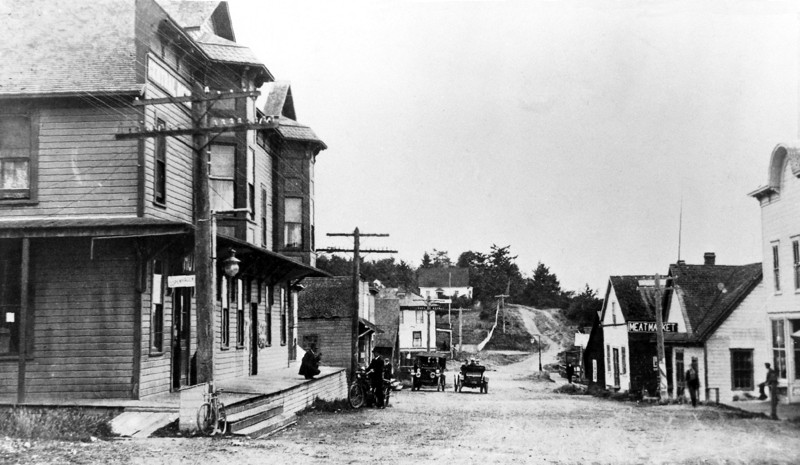
Sill House as a Meat Market between the Bowers & Kineth building and the Bartlett building (no longer there) on the right.
Note the Central Hotel on the left of the picture
Courtesy: Island County Historical Museum, Coupeville
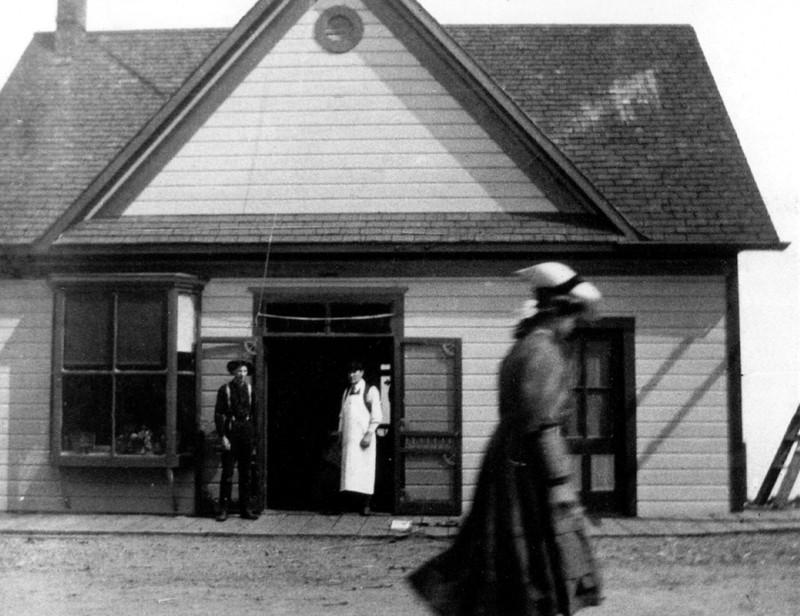
Sill House as a Meat Market.
Courtesy: Island County Historical Museum, Coupeville
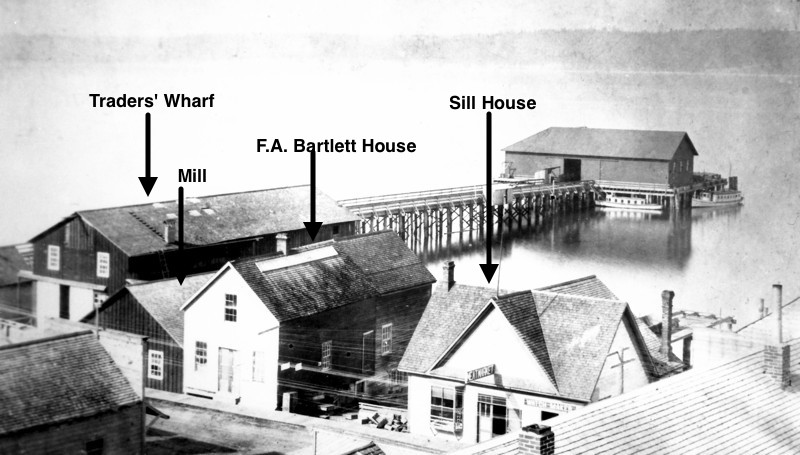
Sill's House with a Meat Market and a Watch Maker. To its left are the Bartlett building, The Livery and the Coupeville Wharf. The picture was taken from the top of the Central Hotel (no longer there).
Courtesy: Island County Historical Museum, Coupeville
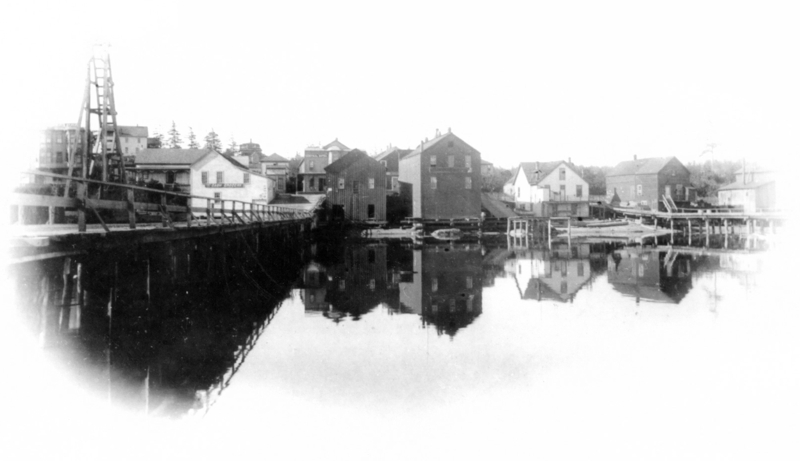
Sill's House is the light colored one on the right. Further right are the Bartlett building (no longer there) and the Terry's Dryer / Gillespie's Livery / Traders Wharf / Windjammer fading off the picture. Note that the Mill is not in the picture.
Courtesy: Island County Historical Museum, Coupeville
The Sill house was moved to the west of the State Hotel (now the location of the museum)
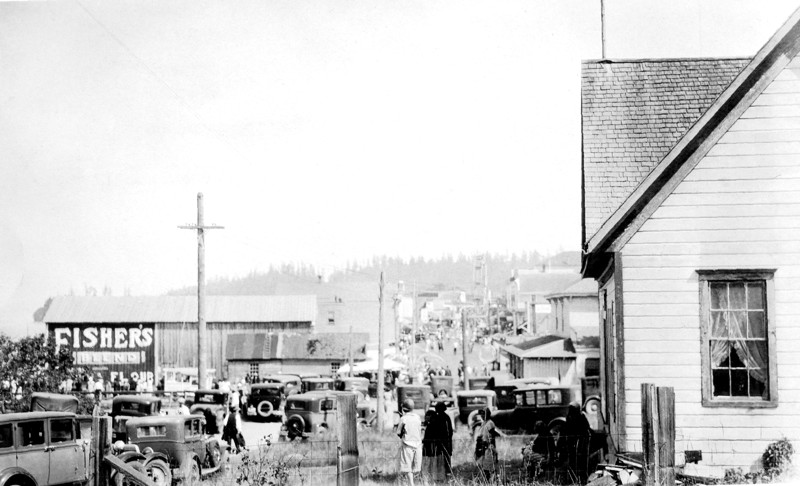
Sill House on the right after being moved the first time. The picture looks east along Front Street and was probably taken during a water festival (note the ferris wheel in the distance) in the 1930s.
Courtesy: Private collection of David Engle
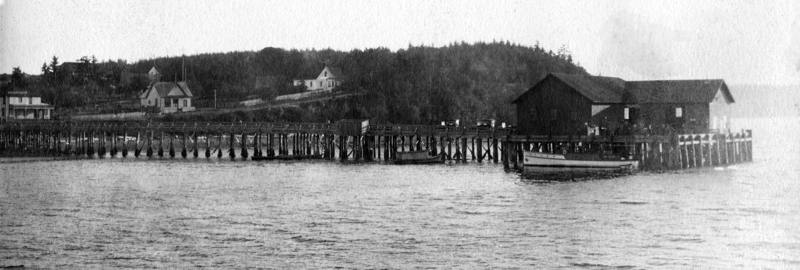
Sill House to the right of the hotel with the new Coupeville Wharf.
Courtesy: Island County Historical Museum, Coupeville
The Sill house was moved a second time and now is at 180 NW Coveland. It is occupied by the Economic Development Council and a lawyer office.
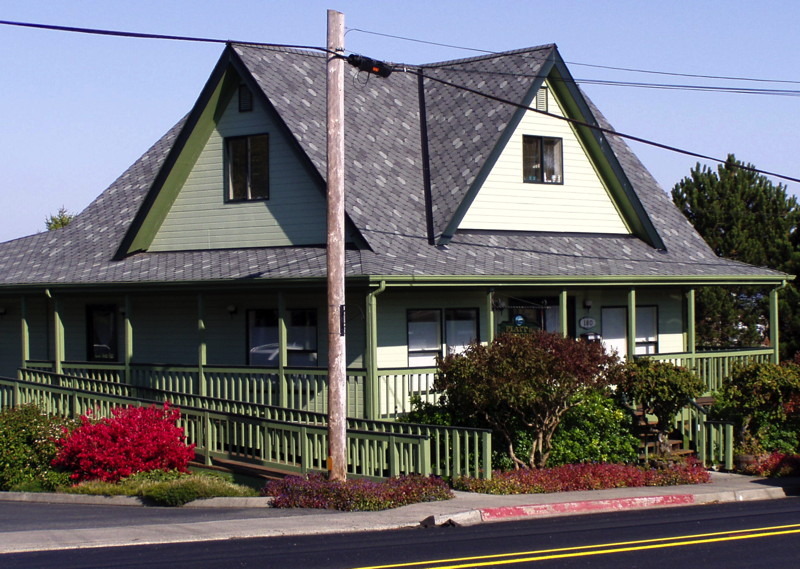
Sill House today on Coveland.
Courtesy: Robert Y Elphick, 2013
1916 - This building was constructed for Sam and Nellie Benson. They operated a gift store and confectionery on the main floor and lived in an apartment on the 2nd floor. It had 3 separate spaces confectionary, dining room, and a kitchen in rear. It was long operated by Robert Miller, Chet Howard & Thelma Howard.
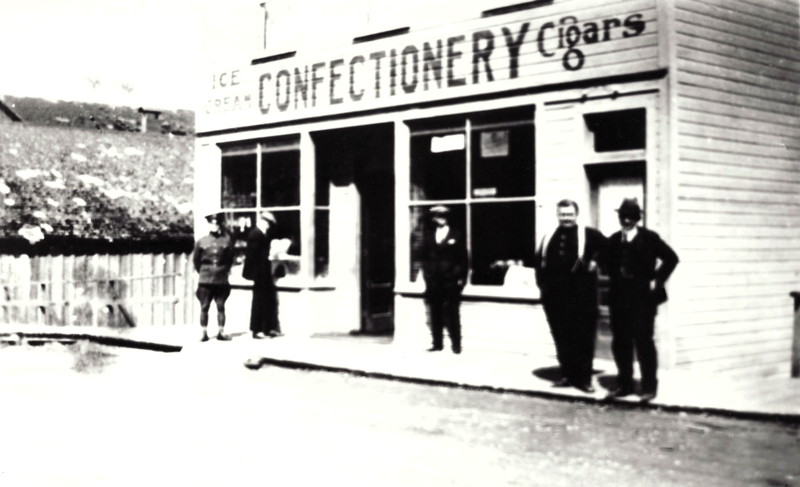
Benson Confectionary. Sam Benson is the second from the right.
Courtesy: Island County Historical Museum, Coupeville
Quote from "Images of America - Coupeville"
All over-the-water buildings on Front Street had toilets that emptied onto the beach. This building (now the Kingfisher) contains the only remaining one. The tide flushed twice a day.
*Interview by Judy Lynn with Barry Brown, 2009.
The Howard's were my aunt and uncle. Thelma Howard had a confectionary shop where the Kingfisher (Benson's Confectionery building) is now. She lived upstairs. My mother's family lived there before. My mother lived in that building for years. I think my mom's parents had a liquor store there. Mom was a teenager when she lived there for a few years.
*Interview by Judy Lynn with Leone Argent, 2009.
I remember Benson's Confectionary when I was still living in Coupeville. I remember going in…Mr. Benson was always sitting on a chair, leaning again the wall on the left side. He wore black trousers and black sateen shirt. His candy counter was on the right. I would come with a couple of pennies and he would get up and go to the candy counter. I would look and look and give him two pennies. All those kids that would make him tip his chair down for just two pennies. He acted like he was doing us a favor. He wasn't
getting paid for his time and effort.
Next door was Nells Sill's grocery store (Coupeville Cash Store). I remember a big keg or jar of peanut butter—several gallons of peanut butter. He had a big dipper and he would fill your carton with peanut butter. When I was in high school, during the summer, Sills had some business in Port Townsend that would bring clothing to sell. They sold from the mezzanine. I bought yellow slacks and yellow top. I still have a picture of me wearing them. My boyfriend (later husband) bought me a cap to go with it. He liked that outfit.
*Interview by Judy Lynn with Ilah Engom, 2009.
On the water side, the Miller's had the liquor store (Benson's Confectionary). They had two daughters, Betty and Patty, when I was in high school. I think her married name was Brown. I had sodas at their fountain. Patty was younger than I was. She ended up living on the prairie. One side of that building was the liquor store and the other side was the soda fountain. Thelma Howard and her husband owned it in later years.
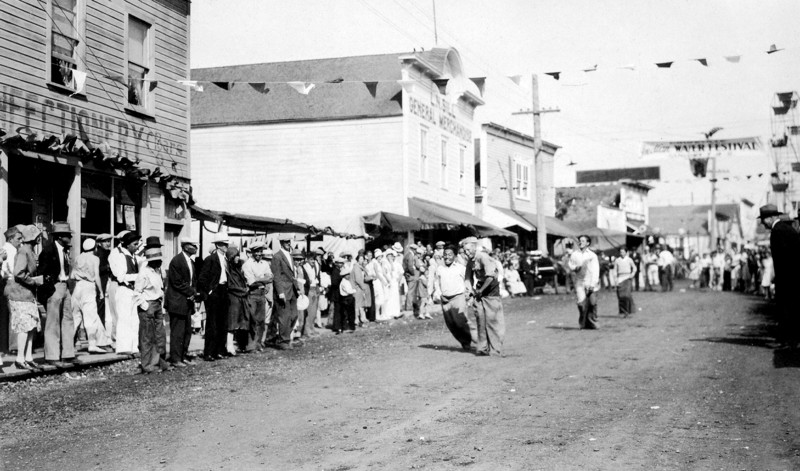
Benson's Confectionary on the left during a race in the Water Festival.
Courtesy: Island County Historical Museum, Coupeville
*Interview by Judy Lynn with Joanne Engle Brown, 2008.
The Benson's Confectionary had a soda fountain. The Miller's had a lot of gift items. It was owned by the Howards later. My uncle George (G.Dub) was 15 years older than me but when he was in his teens and early twenties he would take me and (brother) Bill there for milk shakes.
*Interview by Judy Lynn with Josephine DeVires, 2009.
Sam Benson owned the Confectionary. He would come up to our store and talk to Dad. He was getting pretty fat. He asked if I could go with him in the boat to fish. He was getting too fat to take the boat out. His kids wouldn't let him and he couldn't go by himself so I'd fish with him. I liked to fish but I didn't like to clean them. Nellie was his wife.
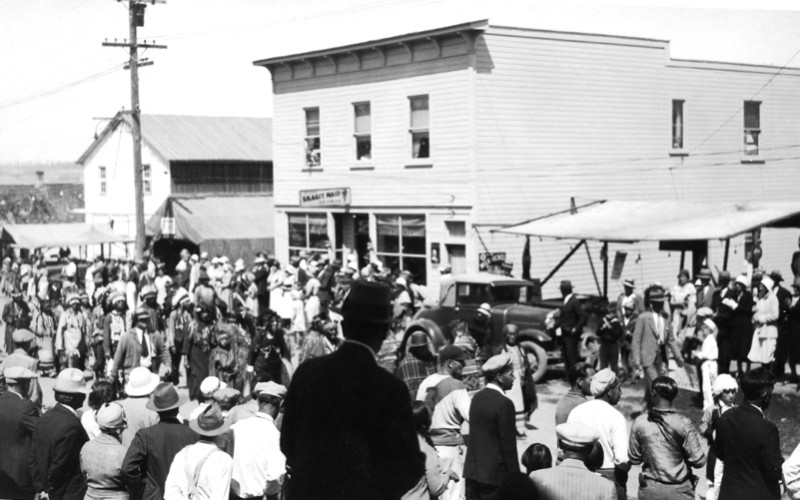
Another Water festival with native american's in the parade.
Courtesy: Island County Historical Museum, Coupeville
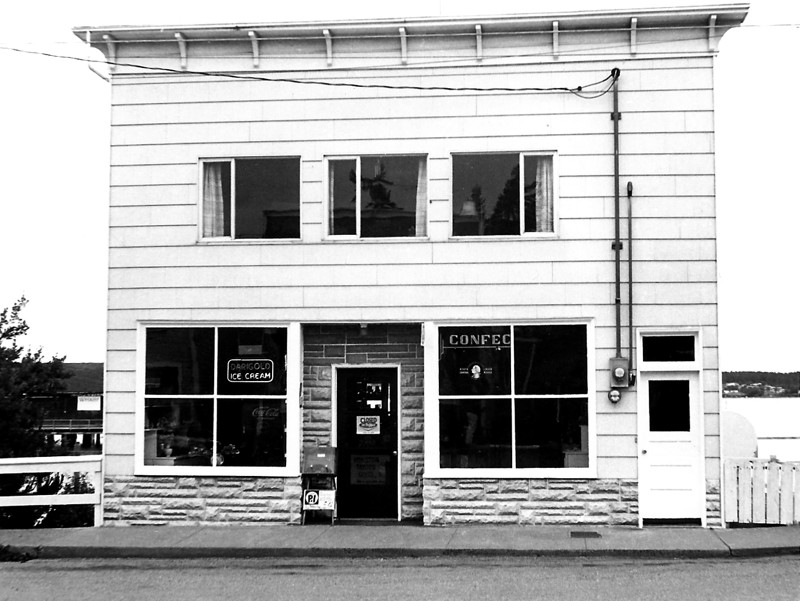
Confectionary. Note the upgraded windows upstairs.
Courtesy: Island County Historical Museum, Coupeville
*Interview by Judy Lynn with Janet Enzmann, 2009.
One of the stories I told was about the vertical "Two-holer" under (what is now) the Kingfisher [Benson's Confectionery]. I talked with Gordon Gookinss about the grocery store tossing out expired goods onto the beach and when he and his friends ate ExLax that they thought was gum.
*Interview by Judy Lynn with Mille Fonda, 2009.
People would throw garbage out the back of these buildings on Front Street and there were privies at the end of each building that dumped into Penn Cove. There is still one in Karl King's building (Benson's Confectionery) next door. You can look up from the beach and see the hole. Gordon Gookinss said he and his friend found what they thought was Chicklets gum on the beach and they chewed several packages. It was X-Lax and they were so sick.
Thelma and Chester Howard owned the liquor store in the 1940s and 50s. Howard's Gift Shop was in front and the liquor store was in the back part. They lived upstairs. Indoor plumbing was installed in 1950s.
1970's A false front and new foundation were added by Mel Case. Bricks and concrete were used in the basement. Aluminum windows were put in upstairs and the facade upgraded.
1980s - King's Liquor store
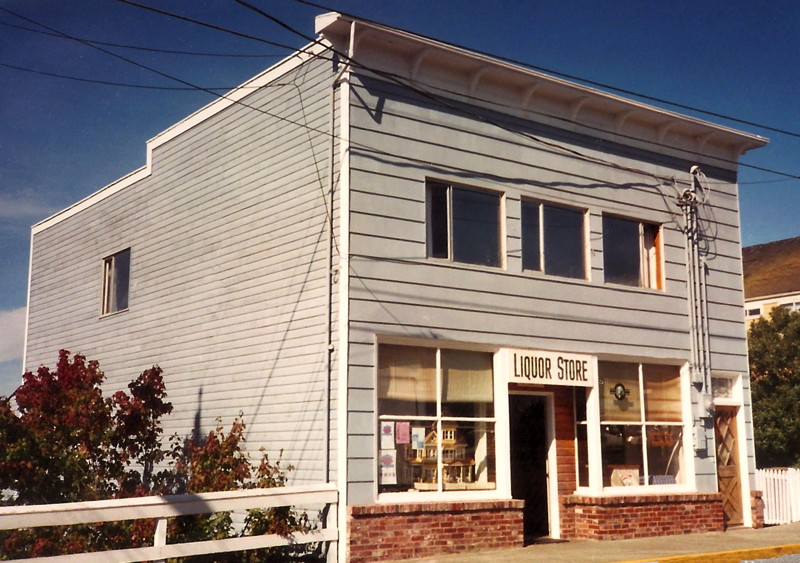
Liquor Store.
Courtesy: Island County Historical Museum, Coupeville
*Interview by Judy Lynn with Millie Fonda, 2008.
Millie: Karl King and Ruth had a liquor store in the building (Benson's Confectionery) before the Kingfisher Book Store. The very first person I met was Judy Harper that lived upstairs in King's building. Chuck and Sandy Poust [Windjammer in Terry's Dryer building] moved here the same time we did.
*Interview by Judy Lynn with Karl King, 2009 at Kingfisher Bookstore on Front Street
Judy: Tell me about how you came to Coupeville and to this building.
Karl: We were already living on Whidbey Island at Mutiny Bay and trying to make a living. I was working in Seattle, tending bar. At that time I was still at the Miribeau Restaurant in the SeaFirst building. The owners of this building, Mel and Mary Case, had a daughter and she was goddaughter to a friend of mine. They were looking to sell their building. I talked with them, found out the terms and Ruth and I spent the next three weeks trying to find the money for the down payment. We came up with it and closed 30 days later, in I think 1981. I think we are the only 4th owners of this building.
Mel and Mary were living upstairs in the apartment. They had refurbished the whole building. He was a building contractor and he was the Mayor of Coupeville.
After they bought the building from Thelma Howard they took out the snack and confectionary part and turned the whole main floor into a liquor store. They shored up the middle of the building with supports underneath, put in a new sea wall, filled in the cistern and replaced the electrical wiring. I don't know how long the refurbishing took. In the basement area he had a shop set up that he used after he retired from being a general contractor. He put up some of the shelving inside the building.
They also owned the "Laundrymat" across the street. [Note: That building is the at the corner of Grace and Front.] We bought both buildings. They wanted out completely.
Judy: Were they running the Laundromat as well as the liquor store?
Karl: Yes. They continued to live in the two-bedroom apartment upstairs for a couple of months and then left town. I think they moved to Lacey. I didn't know them well. Mel died in about 2007 at age 90 plus. Mary passed 2 or 3 years before.
Judy: Is the apartment upstairs the full size of the building?
Karl: Yes. It's rented now. I lived up there for 6 months after we bought the building to see how the business and the town went. Then we figured it was better to rent it out and commute to home.
Judy: What is downstairs?
Karl: A full size empty basement.
Judy: What did you do once you bought the building?
Karl: Once we got the OK from the state liquor control board we were able to be in business. It was a liquor agency.
Judy: Tell me about that.
Karl: The Oak Harbor store is the only state operated liquor store on the island. The rest are agencies, operated independently by the individual. The state sets the prices and supplies the store with liquor on bonding. You have to follow their rules and you get paid on a descending tier. You pay your own expenses.
Judy: Was than an adjustment for you, being in business?
Karl: I had tended bar for 25 years but the merchandising was new. It wasn't well defined and it was a closed market. I was an agent for the state.
Judy: How long did you have the liquor store?
Karl: We had it a total of 14 years. I started working it and ran it for a couple of years and then Ruth ran it for a couple of years while I worked again in Seattle. After I was out of the business, it moved across the street. Pam Degolier opened it in the former Laundromat building.
Judy: Would you tell me more about the Laundromat across the street?
Karl: I rant it for a few years and I sold the business to the Duschek's from Oak Harbor. They ran it as a Laundromat for quite a while.
They sold the business and building to someone from Everett and Freeland. He owned a retirement or nursing home in Freeland and he wanted the Laundromat to do the laundry for that business. He wound up in jail and I wound up with the building back. He had taken the old machines out and put in very large commercial units. It wasn't for public use anymore. Anyone who wanted to do laundry had to go to Oak Harbor. And then the cost of water had been raised. Duscheck had to raise the prices even before the summer rate increase. It took a long time after the sale defaulted to get the building back. We let it go to auction because we didn't want to mess with it any further. Shelby and Kathleen Quinn bought the building and they put in an antique shop.
Judy: I know they had an antique shop in the building at 7 NW Front. Did they have two businesses at the same time?
Karl: For a period of time they had two antique shops, then they leased the old Laundromat building out.
Judy: Back to this building, what did you do after Pam opened the liquor store across the street in the Laundromat building?
Karl: I had a knee operation and the building sat bare for about 10 months. Nobody wanted to pay rent for the amount of space available here. We were trying to figure out what to do with it and my wife said, "We both like books. Let's open a book store until we can rent or sell it." We opened the Kingfisher in 1995, about 2 months before Amazon came on the scene. That's almost 14 years ago.
Judy: How has the book business been?
Karl: Sporadic. It had begun building then there was a change in the U.S. political system. Business fell off after Mr. Bush came into office and it stayed static for about 8 years. That's the way this business was.
Judy: What else can you tell me about being in business on Front Street?
Karl: It's seasonal. We reduced the hours at one point by closing earlier. We noticed that around 4:00 to 5:30 a lot of people would come in but sales were non-existent. The majority of people were waiting for reservations at a restaurant. They were beating the books up with no appreciable return so we started closing at 4:00.
In general, during the tourist season, we were open 7 days a week. Now we're open 6 days a week. We started closing on Tuesday but the restaurants closed Tuesday so then we switched to Thursday. My wife, Ruth, works 2 days a week and I work the other 4, Wednesday through Sunday.
Judy: What is your biggest market?
Karl: We're general. I try to mainly hit the Northwest part for people who come from out-of-state who want to take back a memory of the island. That's a third of our sales. Since the Iraq war we don'’t see so many people from around the country. People used to come from the Southeast and Midwest to visit family members in the military on Whidbey. Now they're mostly on duty and away.
The number of people coming from out-of-state has changed since the economy as been poor. They are mostly from the West and not traveling so far. A lot of people are on their way to Canada. That may slow until they get their own passports. Not nearly so many from Canada since the exchange rate changed. When the exchange rate was from 9% to 11% as opposed to 30% they used to come for clothing shopping. Their value-added tax is another factor, as is the lack of ferry to Port Townsend.
We enjoy our business. We have had the building up for sale. When the economy went down we re-rented the upstairs. We will put it on the market again. One person is living upstairs now. Prior to that it was rented by a man who was born and raised in Coupeville. He lost his job so signed up to go back to Iraq.
Judy: Did Chris Christenson live in your apartment"
Karl: Yes, she rented it for 4 years. Then I had a leakage problem from the roof. It leaked into the bedroom she used. I couldn't get anyone to fix it. She moved off the island. [Note: Chris was a retired nurse and was very active in the Chamber of Commerce and the Coupeville Festival Association.]
Judy: What do you remember about Front Street when you first bought the building?
Karl: Lynn and Bob Jackson had the Coupeville Weaving Shop across the street. (In the Bishop building.) They had a good, healthy trade. Lynn was a real nice lady. (Note: Karl pointed out a weaving that he got from Lynn Jackson.) She was demonstrating weaving at the elementary school when she had a stroke. Bob offered to sell me the two houses he had built behind the Coupeville Inn but I didn't have the money. Jim and Lee Anderst bought the shop and they had a big trade and expanded too.
Where Collections is was a shop run by Frank and Dotty Lawhorn.
The N.L. Still house used to sit where this building is. It was moved to where the condos are now. When they were built it was moved to Coveland. The owner and back portions were added. There is a picture in Jimmy Jean Cook's book.
Before Quinn's Antiques, that building [#7 Front Street] was a specialty china shop owned by the Mitchell's. In the winter they traveled around and purchased while they were gone. He was a retired FBI agent. I believe he held the lead office in Seattle. He died first and then she did. They had 2 or 3 daughters that closed out everything there and sold the building.
This is one of the only buildings on Front Street that has a flat slanted roof designed as a collector to drain rain water into the cistern in the basement. In the apartment upstairs there was a hand pump that pulled water from the cistern. They didn't get water on Front Street until years later.
I have a copy of the survey for the Alexander plat, signed by the Territorial Governor, before Washington was a state. The buildings were built parallel to the street, but the lots are at an angle. Ken Kroll owned the lot across the street where Ursula Dodd build her building (#13 Front Street) and next to the Laundromat. Ken and I swapped portions of our lots for a dollar so the property line went parallel to the Laundromat building. That squared off the lot and he sold it to Ursula.
There is supposedly an open easement 10' behind the buildings from Grace to Mariner's Court. Ursula put parking behind her building.
There are 2 lots between this building and Millie Fonda's next door. (#12 Front Street) She has one and I have the other. I believe I have the only buildable lot.
1995 - Kingfisher bookstore opened by Karl and Ruth King
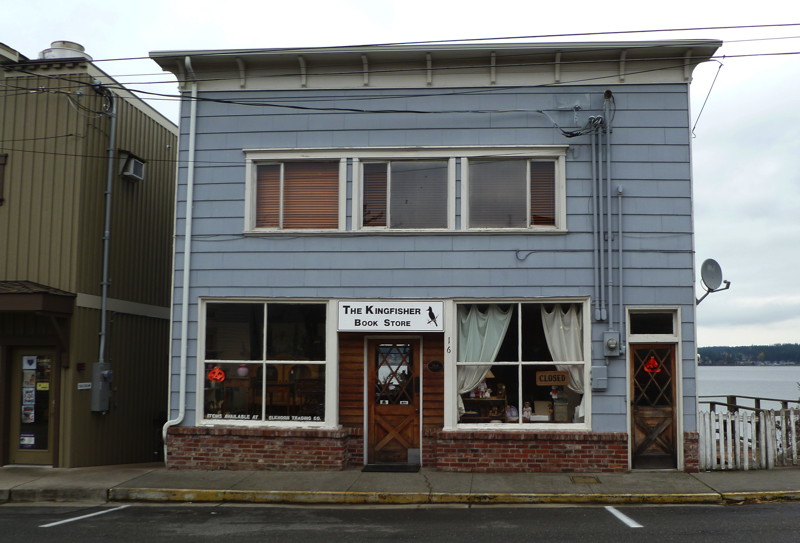
Kingfisher Bookstore.
Courtesy: Robert Y Elphick, 2013
2018 - The Kings sell the building and bookstore to Meg and Brad Olson
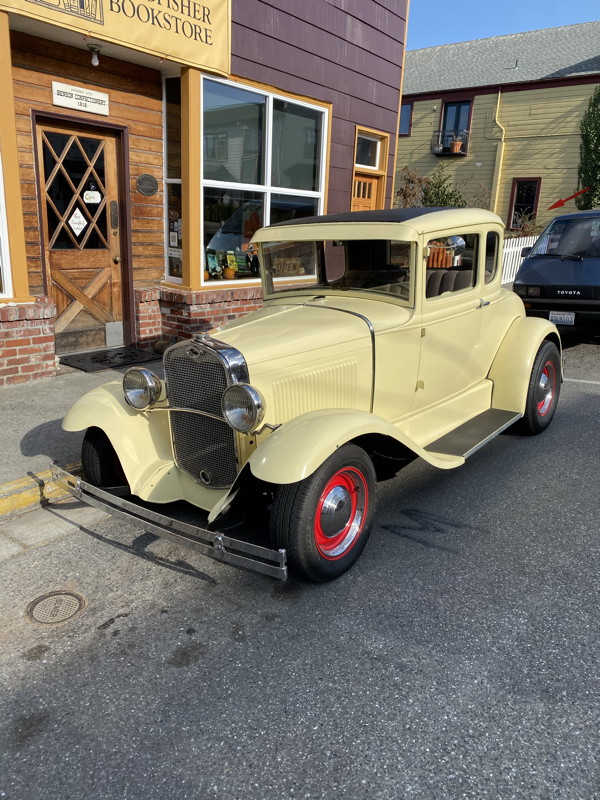
Kingfisher Bookstore.
Courtesy: Robert Y Elphick, 2019
(OK, I really shot the car!)
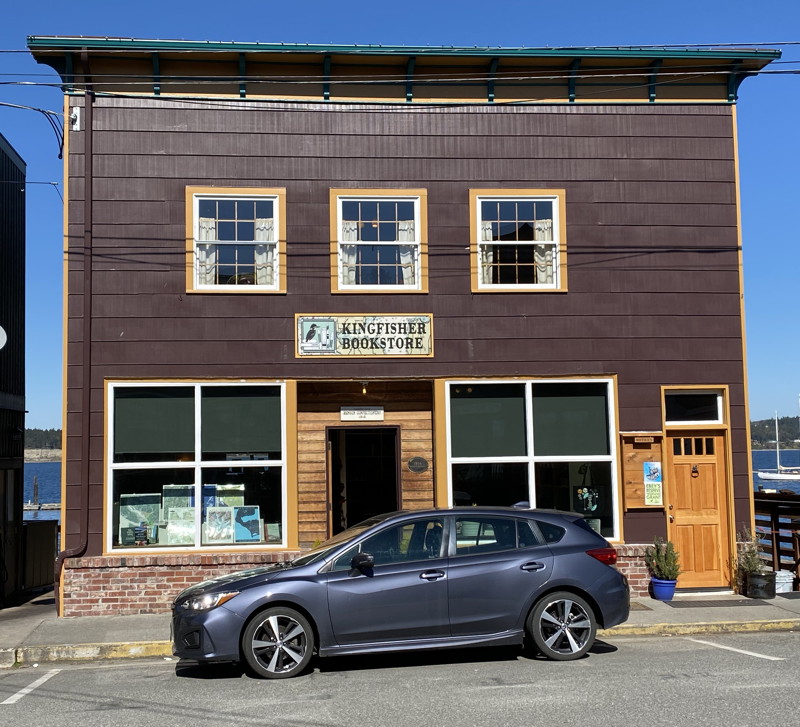
Kingfisher Bookstore.
Courtesy: Robert Y Elphick, 2020
* All the interviews are extracted from the Judy Lynn's Oral History Project. Judy Lynn interviewed everyone she could find who had any memories of the history of Front Street. For more information on the project contact the Whidbey Island Historical Musem, Coupeville.
The e-book Front Street, Coupeville - An Oral History by Judy Lynn contains all the interviews. It can be purchased for $9.99 at Amazon.com for Kindle application or device or from the Apple Store for iBooks applications. Proceeds go to the Island County Historical Society.


